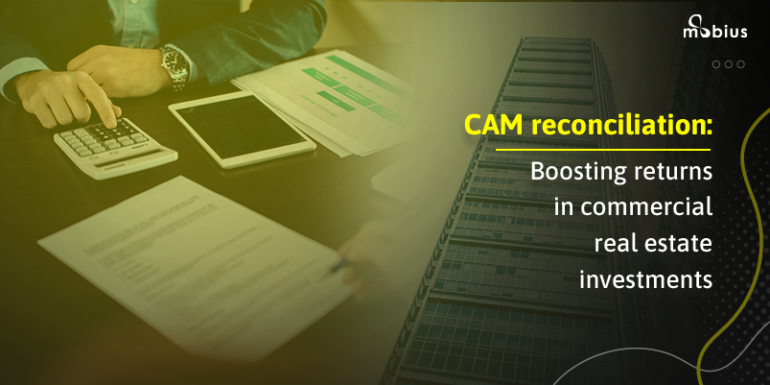Commercial real estate investments offer investors opportunities to earn substantial returns. Even though global inflation is expected to decline by 6.5 percent in 2023, investing in commercial real estate will remain profitable. However, the challenge is that commercial real estate investments involve complex contractual agreements, such as CAM reconciliation, which makes property management complex.
To maximize investment returns, investors must carefully manage and optimize various aspects, including common area expenses. Additionally, investors and property managers need to establish a property budget to ensure that the maintenance cost does not exceed the income generated from the property. To avoid unforeseen expenditures, it is essential to see that expenses are properly budgeted and the property is well maintained.
Investors, landlords, and managers must ensure that their tenants receive fair and accurate allocations of common area expenses. The tenant or landlord must pay these Common Area Maintenance (CAM) expenses based on the lease agreement.
This blog post explores the concept of CAM reconciliation and explains how it can significantly increase commercial real estate returns.
What is CAM reconciliation?
Reconciliation of Common Area Maintenance, also called CAM reconciliation, is a crucial process associated with commercial property management. The process involves reviewing and adjusting tenants’ common area maintenance charges for renting commercial properties.
The Common Area Maintenance charge covers expenses associated with the operation, maintenance, and common area repairs. These areas include lobbies, hallways, parking lots, elevators, landscapes, etc.,
How is CAM calculated?
CAM is calculated by dividing the total expenses incurred in maintaining the common areas among tenants according to their pro-rata share or the percentage of space they occupy. The resulting amount is known as CAM charge or CAM fee. Typically, every tenant is required to pay this amount on a quarterly or monthly basis.
It’s imperative to note that the specific items included in CAM and the calculation method may vary depending on the lease agreement and property management practices. To understand how CAM charges are determined and allocated in a specific property, tenants and landlords should thoroughly review the lease terms.
Why is CAM reconciliation necessary for commercial property investors?
CAM reconciliation holds significant importance for commercial property investors due to several reasons. Firstly, it ensures an accurate and fair expense allocation among tenants. CAM reconciliation allows property investors to determine the costs incurred and reconcile them with the estimated charges collected from tenants.
Secondly, CAM reconciliation makes financial transactions transparent and accountable. By reviewing and reconciling CAM charges, investors can maintain accurate records of expenses related to common area maintenance. This transparency is essential for gaining trust and fostering positive landlord-tenant relationships.
Thirdly, CAM reconciliation allows investors to assess the financial performance of their commercial properties. By comparing the estimated charges with the actual expenses, investors can identify any cost discrepancies, inefficiencies, or areas for improvement. Thus investors can make informed decisions regarding budgeting, expense management, and property operations.
Furthermore, CAM reconciliation also helps investors accurately forecast expenses and budgets for upcoming periods. By analyzing historical CAM data and trends, investors can anticipate potential fluctuations in expenses and adjust their financial plans accordingly. This proactive approach enables them to allocate resources effectively and avoid financial surprises.
Difference between CAM reconciliation and CAM audit
CAM reconciliation and CAM audits are two distinct processes that play crucial roles in commercial real estate management. While both involve reviewing common area maintenance charges, the two differ in some fundamental ways.
CAM reconciliation compares tenants’ estimated common area maintenance charges with the expenses incurred for maintaining and managing common areas. It typically occurs annually or at specified intervals to ensure accurate cost allocation among tenants. The goal is to adjust tenants’ accounts based on any overpayment or underpayment of CAM charges.
On the other hand, CAM audits involve a thorough analysis of financial records and processes associated with CAM charges. The audit consists of reviewing invoices, contracts, and financial statements to identify potential discrepancies, errors and ensure compliance with lease agreements.
Overall, CAM reconciliation focuses on the fiscal adjustment and allocation of costs, while CAM audits go beyond reconciliation and provide a deeper level of scrutiny and analysis.
How challenging is CAM reconciliation for property investors?
CAM reconciliation can be a challenging part of property management for investors, but it is not tricky. While it involves complex calculations and meticulous attention to detail, understanding the common pain points and implementing effective strategies can streamline the CAM reconciliation process.
One of the primary reasons why common area maintenance reconciliation is challenging for commercial property investors is the high volume of data. Commercial property investors often deal with projects with unique lease agreements and CAM expenses. Collecting, organizing, and validating this information requires additional effort and is susceptible to human mistakes. Additionally, discrepancies between estimated charges and actual expenses can arise, leading to complications and potential tenant disputes.
CAM reconciliation functions based on accurate determination and allocation of shared expenses. It requires a deep understanding of lease agreements, industry standards, and local regulations. It is vital to allocate expenses properly to avoid financial losses for property owners and dissatisfaction among tenants.
Furthermore, CAM reconciliation often involves coordinating with service providers and vendors who maintain and repair common areas. Managing invoices, tracking payments, and ensuring the accuracy of bills can be hectic. Coordinating with multiple parties and reconciling their invoices against the estimated common area maintenance charges adds another layer of complexity to the reconciliation process.
How to overcome CAM reconciliation challenges?
Common area maintenance reconciliation can present various challenges for property managers and investors. Investors can overcome obstacles with effective strategies and approaches.
Here are some practical ways to address common area maintenance reconciliation challenges and streamline the process:
Thorough lease agreement review
The review starts with carefully understanding lease agreements and defining eligible CAM provisions. The analysis also involves understanding allocation methods and any requirements outlined in the leases. Property investors must ensure lease agreements are clear and well-defined to lay the foundation for smooth common area maintenance reconciliation.
Engage with experienced property managers
Property investors must collaborate with experienced property managers well-versed in CAM reconciliation best practices. They can handle the day-to-day aspects of the CAM reconciliation process, including data collection, expense verification, and tenant communication. Property managers’ expertise and knowledge can help navigate the complexities of the CAM process, ensuring accuracy and efficiency.
Implement technology solutions
Leveraging property management software or accounting systems can streamline property expense reconciliation tasks. These tools can automate data collection, generate accurate reports, and perform calculations, reducing manual errors and saving time. Commercial property investors can streamline the CAM reconciliation process and improve efficiency by implementing technology solutions.
Maintain transparency with tenants
It is important to have effective communication with tenants for successful CAM reconciliation best practices. Property managers must regularly engage with tenants to provide updates on CAM charges, explain the reconciliation process, and address any questions or concerns they may have. Transparent and open communication builds trust and minimizes disputes, leading to smoother reconciliation outcomes.
Conduct regular audits
Conducting a periodic audit of the CAM reconciliation process ensures accuracy and identifies potential areas for improvement. Audits can help identify any discrepancies or errors, allowing for timely corrections. Commercial property investors and property managers can maintain financial transparency with tenants and optimize cost allocation by conducting regular audits.
Engage professional advisors
Commercial property investors can seek guidance from professional advisors, such as accountants or real estate consultants, specializing in CAM data reconciliation best practices. They can provide insights, offer best practices, and ensure regulations compliance and accounting standards. Professional advice can streamline the process and enhance the accuracy of property expense reconciliation.
Stay informed about industry trends
Keeping up-to-date on new industry trends, regulations, and best practices related to CAM reconciliation can help make informed decisions on property investments. Frequent participation in industry events and webinars and maintaining a close network with other commercial property investors can be helpful with future investments.
Successful reconciliation of common area expenses ultimately contributes to commercial properties’ financial success and profitability.
How can we help you?
Calculating CAM reconciliation for commercial properties can present challenges in property management in various ways. Understanding the pain points and implementing effective strategies can mitigate these struggles.
Investors can streamline the CAM reconciliation process by leveraging technology, maintaining clear communication, and seeking professional expertise. These strategies will enhance accuracy and ensure a unified financial management system. With proper practices, the reconciliation of common area expenses contributes to commercial property investments’ overall success and profitability.
If you are an investor seeking assistance, just let us know your queries. Our team of experts can overlook your property expenses diligently.






